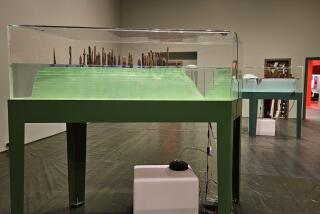Berlin art colony Kunsthaus Tacheles in limbo
Berlin’s got another wall. Last month, after years of hostility between the interests of capital and the communal, a concrete barrier suddenly appeared. Unlike the one that once ringed half the city, this one spans no more than 25 feet and is easily circumvented. And this time, it’s the capitalists who built it.
“It’s the real estate war against mankind,” declares Martin Reiter, spokesman for Kunsthaus Tacheles, a freewheeling art studio, performance space and gallery complex in the heart of the former East Berlin borough of Mitte. And the wall, which Reiter and spokeswoman Linda Cerna have their backs against, literally and figuratively, separates the ornate entrance arch of this turn-of-the-20th-century building with the back court, where a few remaining sculptors, metalworkers and other artists ply their trade. Upstairs, artists from around the world work and exhibit and musicians rehearse. Murals and graffiti cover every surface, complementing the metallic menagerie out back. How long this will survive is anybody’s guess.
“The future, in the eyes of investors, banks and old-style politicians, is no Tacheles anymore,” says Reiter, an Austrian-born media artist. “So we’ll have one demonstration after another.”
When the Berlin Wall fell, East Berlin wheeler-dealers went West in search of opportunity, while artists, punks and squatters streamed in the opposite direction, occupying scores of empty buildings whose landlord was a government that no longer existed. Mitte, then a neglected no-man’s-land, absorbed the brunt of this colonization.
Ground zero was this war-damaged piece of property that came to be called Tacheles — Yiddish for “straight talking,” an homage to the building’s origins as a Jewish-owned proto-shopping mall. “It was a very free period,” Reiter says. Landscape artists converted the courtyard into a post-industrial wonderland featuring a city bus buried Cadillac Ranch-style in the dirt, and a MIG jet. Installations filled the floor spaces visible from outside because of the missing facade, and in the basement, an early techno-house club, Ständige Vertretung, attracted DJs from around the world.
In the 1990s, money and tourists poured into the city, and Mitte found itself in the middle of a property-speculation boom. At Tacheles, two irreconcilable groups formed — one pursuing nonprofit art, happenings and culture, and another made up of entrepreneurs who leveraged their low-overhead positions to rake in cash slinging beer to the pub-crawlers who began flocking here. Conflict ensued.
Then, in early April, the more enterprising coalition, which mostly occupied the ground floor and rear court, sold out for a reported 1 million euros, about $1.4 million. The street-level establishments have been mostly shuttered and the new wall has been put up either to prevent access to new caravans of squatters or to make life difficult for those remaining. Development — which is turning the borough around the building into a Berlin Soho, with flagship stores, luxury condos and corporate hotels — is nipping at its heels.
“The ground floor and those illegal bars out back were following a totally different goal than the arthouse,” Cerna says. “It’s a relief that they’re gone.” Also gone (though much earlier) are pretty much all of the artists who created Tacheles and fought for its survival.
“It’s ridiculous comparing it to the Berlin Wall,” says Gesine Dähn, spokeswoman for HSH Nordbank in Hamburg, which owns the property along with two partner banks.
The bank was involved in a 1997 loan to an investor, Fundus Group, which promised to develop an 83,000-square-foot parcel that included Tacheles after the German government had finally sorted out the ownership issues. Until it could realize its grand but unspecified plans, Fundus allowed the artists to remain and pay token rent, but it defaulted in 2008, leaving the bank holding the title.
Foreclosing on a large chunk of Berlin’s most sought-after district wouldn’t be such a headache were it not for the building being under landmark protection.
“We’re against evicting the artists because it harms everybody’s image,” says Torsten Wöhlert, spokesman for the city’s Department of Cultural Affairs. Wöhlert reiterates the city’s commitment to preserving Tacheles in some form. He points to similar venues, such as the Kulturbrauerei (an old brewery in similarly yuppified Prenzlauerberg), where his department has successfully married the interests of real estate, cultural preservation and publicly subsidized art and performance spaces, though the place is far more sanitized than the ramshackle Tacheles.
What a city that’s $98 billion in debt cannot do, he says, is buy all the property outright as Tacheles is requesting. “They’ve had 10 years to come up with a plan, but they started fighting with each other and produced nothing,” he says in exasperation.
“I Support Tacheles” stickers notwithstanding, many Berliners, though sympathetic to anti-gentrification, have grown weary of the infighting. Alternative scenesters, meanwhile, have abandoned the schickimicki (hoity-toity) Mitte in favor of cheaper districts.
Why not Tacheles? “You need this in the middle of the city because urbanism means life,” Reiter says. “It doesn’t mean Daimler-Benz, it doesn’t mean Nike.”
More to Read
The biggest entertainment stories
Get our big stories about Hollywood, film, television, music, arts, culture and more right in your inbox as soon as they publish.
You may occasionally receive promotional content from the Los Angeles Times.










